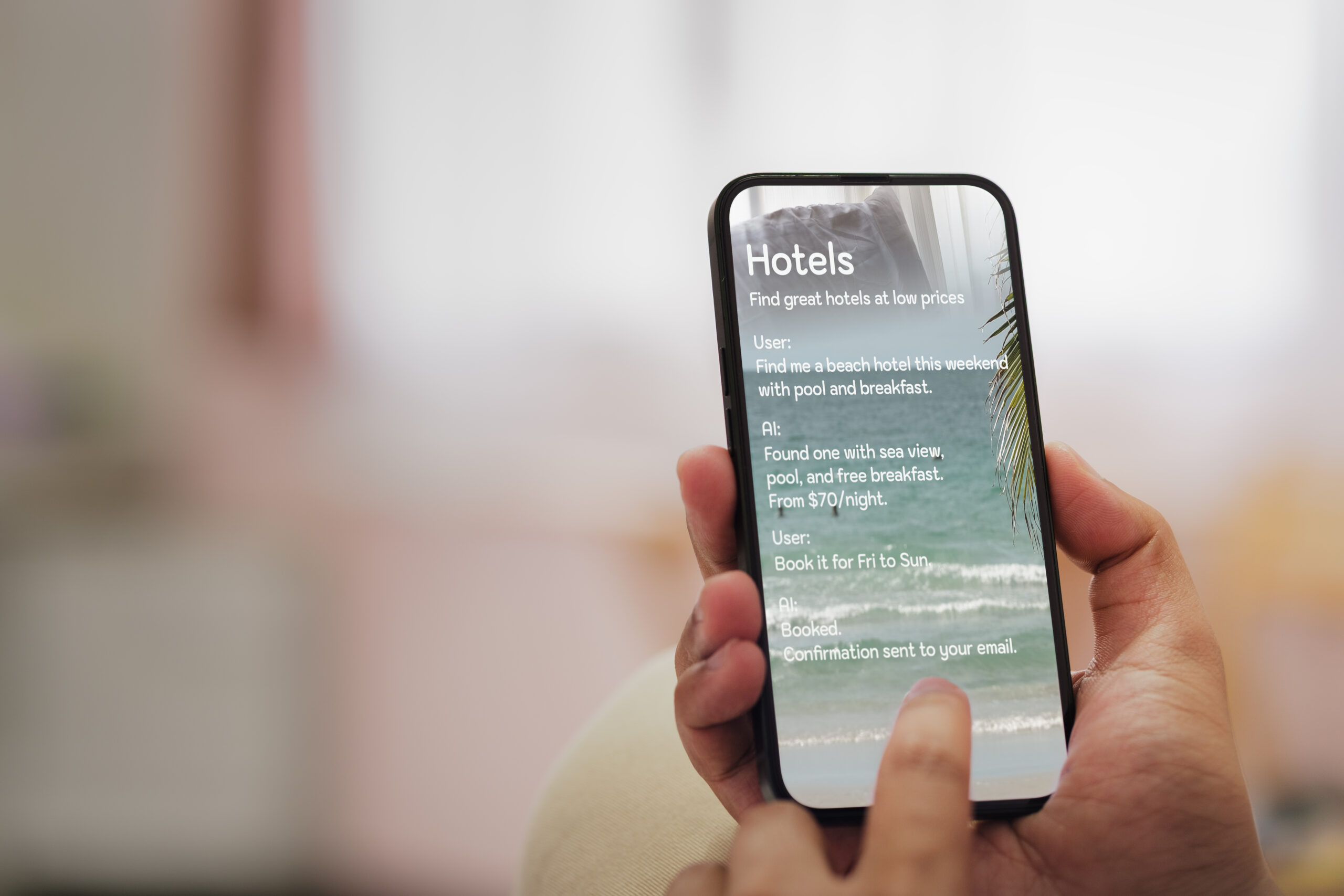Artificial intelligence (AI) has been a part of the travel industry for decades. Large language models (LLMs) have only begun to have a significant impact in recent years. Flight searches, attraction recommendations and full itinerary builders are just some of the ways tools like ChatGPT and Google Gemini are increasingly influencing how Americans plan vacations. A new Beach.com survey reveals that while curiosity and adoption of AI travel planning are high, trust and confidence remain low.
We asked over 1,000 U.S. travelers about their use of AI in travel planning. We asked about the types of decisions it influences, and their level of trust and concern regarding the technology. The results reveal a nation in the early stages of adopting AI trip planners, characterized by a mix of intrigue and hesitation.
AI integration is the future of travel, but there are still barriers thwarting widespread adoption. For those who are not quite ready to trust their travels to an algorithm, there’s still plenty of real traveler footsteps to follow. Check out our very human-curated week-long St. Barts Itinerary, tested and proven by the author who wrote it.
Table of Contents
Key Findings
- 46% of the trips Americans took in the past year involved AI in planning.
- 77% trust AI for travel planning, but only 32% would let AI fully plan a trip.
- AI influences attraction and restaurant choices most, and destination the least.
- 47% of Americans would be concerned or discourage someone from taking a fully AI-planned trip.
How Americans Are Already Using AI for Travel Planning
AI is already at the wheel, steering trips for a majority of Americans. Two-thirds (66%) are already using it to shape some part of their travel planning. The aspects on which AI is having the most influence are travelers’ choices of attractions/stops (43%), restaurants (34%) and lodging (26%). Americans used AI to plan nearly half (46%) of all trips they took within the last year.
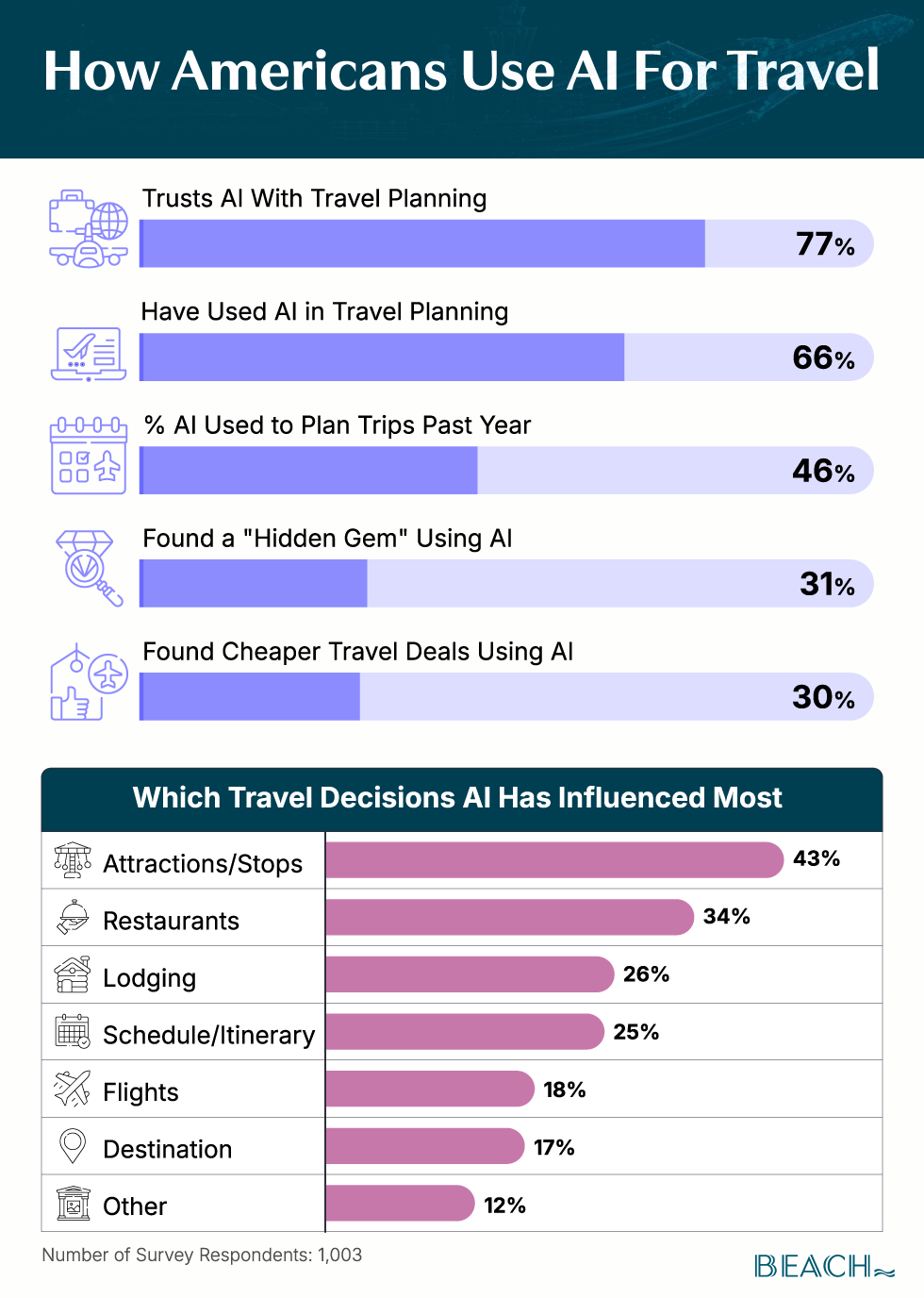
The way Americans use these tools to plan travel reveals a clear pattern. Travelers are relying on AI for the small details while still retaining control over the big decisions. Americans report that AI has the least influence over their choices of destination (17%), flights (18%) and schedule/itinerary (25%).
Travelers are asking AI about destinations, but it hasn’t significantly influenced their final choices yet. Only 31% say they’ve found a “hidden gem” recommendation (destination, lodging, restaurant) from AI they wouldn’t have found otherwise.
Even fewer Americans report having saved money by using AI in their travel planning. Just 3 in 10 say they’ve found cheaper deals with AI, which is the highest money-saving statistic in the study. In a distant second, 16% say they’ve found cheaper alternative routes, and 13% say they’ve avoided fees/unexpected costs. Another 13% say they’ve used it for price tracking/alerts or to create personalized travel budgets.
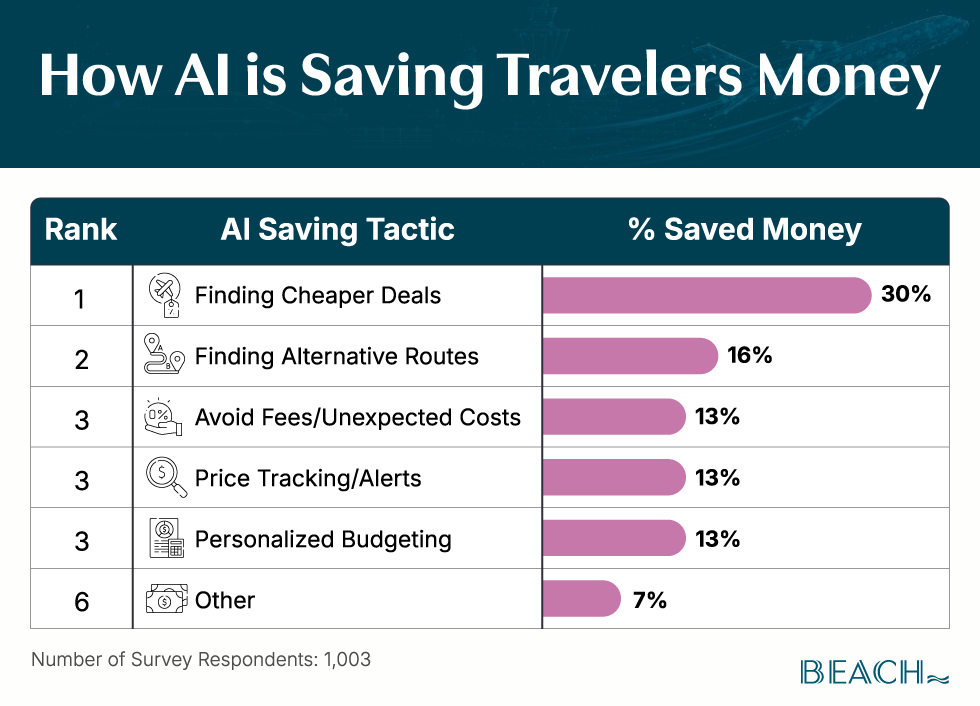
The Barriers to Using AI Travel Agents
Trust and AI travel planning is complicated. Over three-fourths (77%) of Americans say they trust AI for travel planning. However, as stated earlier, these influences are over small details, not big decisions. Only about one-third (32%) would go as far as letting AI fully plan a trip.
Almost half (47%) of Americans say that if an acquaintance told them they were taking a fully AI-planned trip, they would feel hesitant, concerned or actively try to talk them out of it.
When we examine the heart of these hesitations, the reasons are clearly rooted in caution. Outdated or wrong information is the top fear thwarting Americans from using AI travel planners, with 58% citing this concern. Other top concerns are big mistakes, a fear of generic trips and biased results.
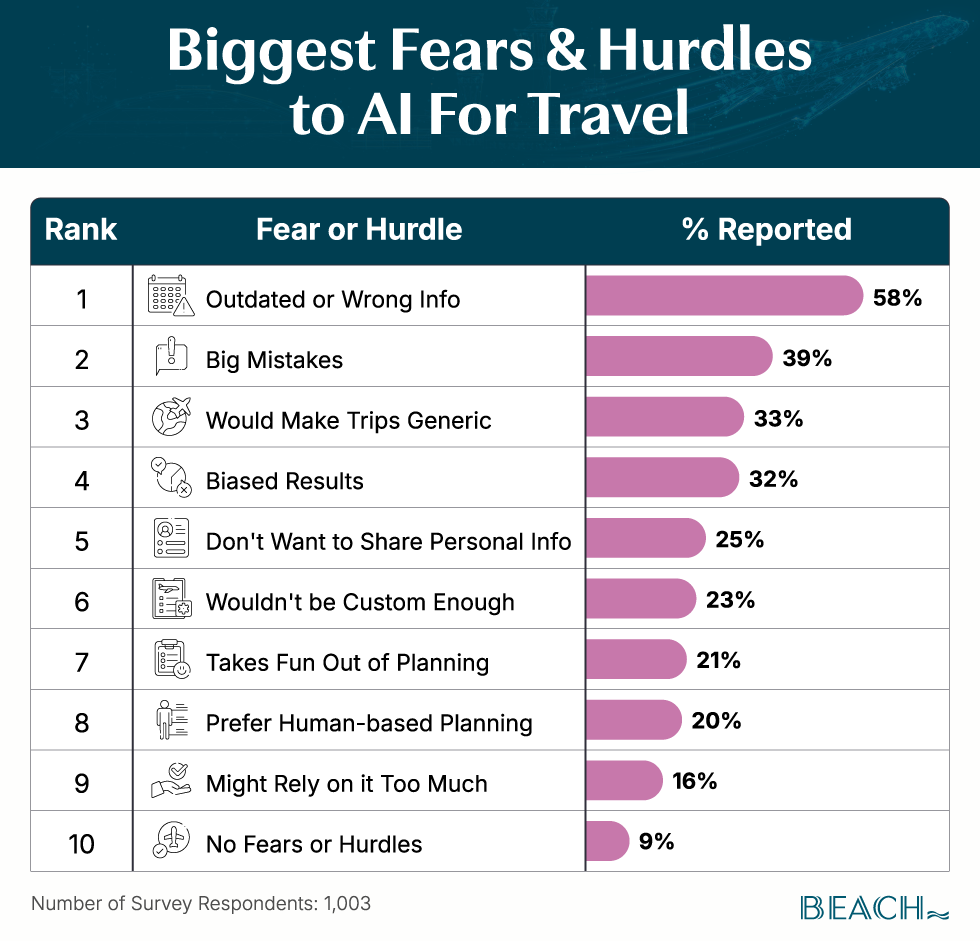
Compared with other travel resources, AI is far from the least trusted. Americans trust their friends and family for travel guidance more than any other source. Traditional online research (blogs, reviews and booking platforms) and travel agents come in second and third, respectively — AI tools, such as ChatGPT, rank fourth.
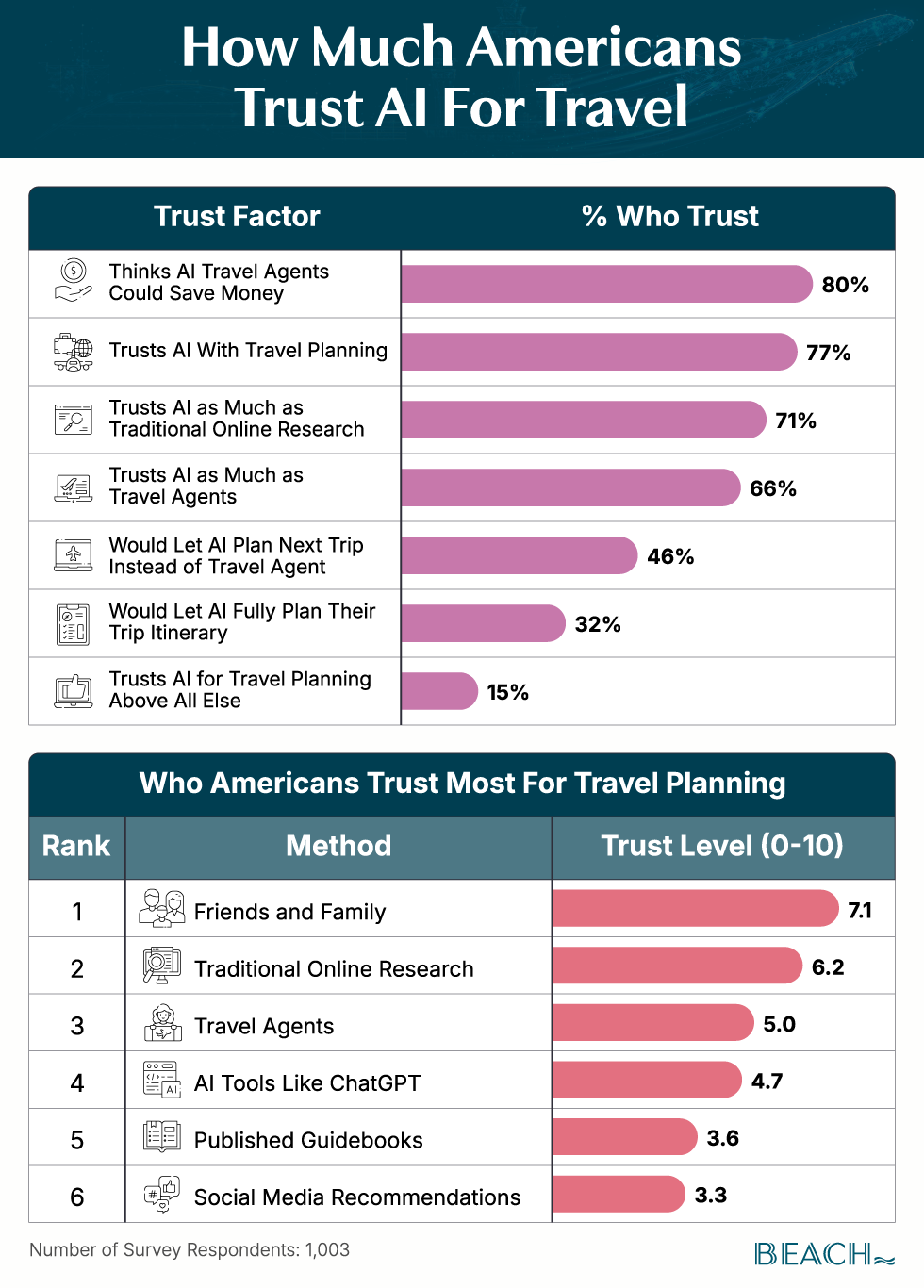
What do Americans trust even less than AI for travel planning? That would be published guidebooks (#5) and social media recommendations (#6).
Demographic Divides in the Use of AI Trip Planners
Demographically speaking, the adoption of AI in travel is varied. The gender divide is particularly noteworthy.
When asked if Americans think men or women use AI for travel planning more, each believes their gender dominates the space. Nearly two-thirds (62%) of men think men use AI more for travel. Three-fifths (60%) of women believe women use it more. Only 37% of men think women are using it more. Only 36% of women think men are using it more.
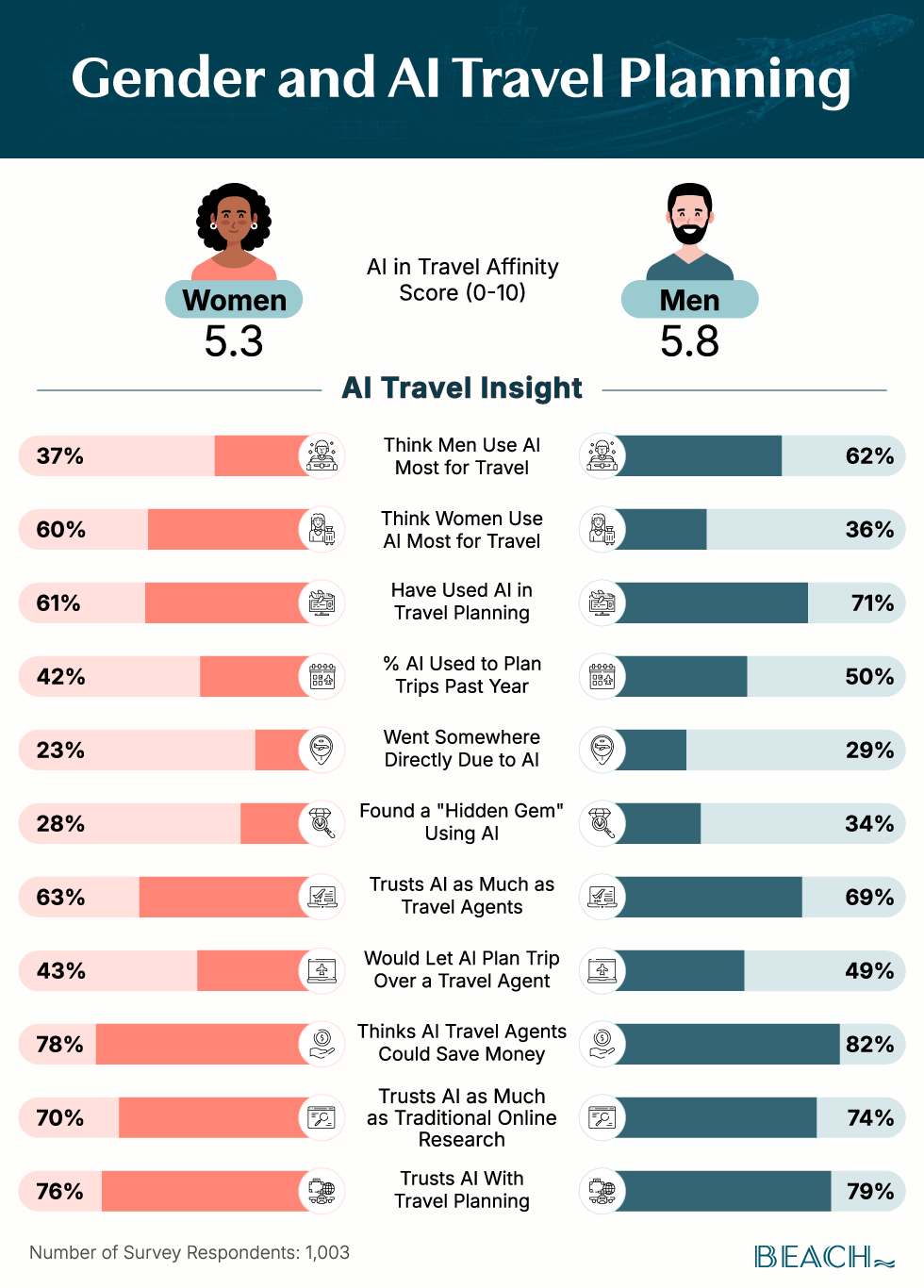
The reality is not nearly as varied. Men are leading the way in adoption, but not by much. Almost three in four men (71%) and nearly two-thirds of women (61%) have used AI to plan travel. In the past year, 50% of men and 42% of women have utilized AI to assist in planning a trip. Men have also had better luck discovering a “hidden gem” through AI (34% vs. 28%).
Generationally speaking, beliefs and usage are opposite to those of gender. Rather than each generation thinking their generation uses AI most for travel planning, the majority of every generation believes Gen Z is using it most.
However, when we tally the rate of affinity towards using AI in travel based on the number of AI-positive survey responses, which we call the “AI in Travel Affinity Score,” it turns out that Millennials and Gen X tie for the highest affinity towards AI.
Gen X planned the most trips, in part, with the help of AI during the past year. They are the most likely to trust AI as they do travel agents or traditional online research. Gen X has the highest rate of those who would let AI plan their next trip instead of a travel agent, and also has the highest trust rate for AI in travel planning broadly.
Meanwhile, Millennials tie with Gen Z as the most likely to use AI for travel planning and are more likely than any other generation to believe that an AI travel agent could save them money.
Gen Z, on the other hand, only leads by having found more travel “hidden gems” using AI and having gone somewhere directly due to AI. Nearly two-fifths (39%) of Gen Z have discovered a “hidden gem” with AI, compared to only 20% of Boomers.
To Boldly Go Where No AI Has Gone Before
Our survey makes clear that while AI may be reshaping and influencing how Americans approach travel, it’s not yet (if ever) replacing the personal touch of human insight. The heart of travel — stories, hidden treasures, serendipity, and spontaneity — is still very human. At Beach.com, we understand this, which is why we continue to spotlight firsthand experiences, itineraries and insider guides from the very people who have experienced them.
“AI won’t replace the human side of travel, at least not anytime soon,” said Dayne Ford, CEO of Beach.com. “People still want reassurance from someone they trust, whether that’s a travel agent, a friend, or a guide who’s actually been there.”
Balance your tech-driven travel planning with tried-and-true wisdom from our seasoned travelers. Or skip the bots altogether and lean into our local knowledge, such as our guide to Oaxaca beaches or this secret beach town 25 minutes from Cancún.
Sources and Methodology
On September 4, 2025, we surveyed 1,003 Americans who take trips/vacations at least once a year about how much they use AI in travel planning. We asked respondents to report which aspects of travel planning AI influences the most, whether AI has helped them save money in travel planning, how much they trust AI for travel planning, and more.
To establish our “Trust Level” scores, we asked respondents to rank six travel influences by their level of trust. We averaged the rankings per influence and transformed them to a 10-point scale. To establish our “AI in Travel Affinity Scores,” we averaged the percentage of respondents in each demographic who answered positively to questions about AI in travel and transformed the results to a 10-point scale.
Respondents ranged in age from 18 to 77 years old, with 49.2% female, 49.5% male, 1.1% nonbinary, and 0.3% preferring not to say.
Fair Use
When using this data and research, please attribute by linking to this study and citing Beach.com.

